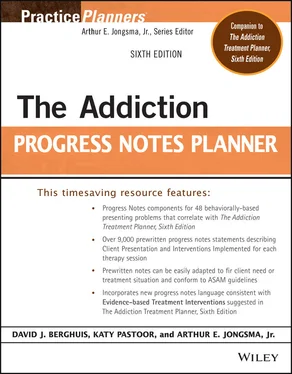The Addiction Progress Notes Planner
Здесь есть возможность читать онлайн «The Addiction Progress Notes Planner» — ознакомительный отрывок электронной книги совершенно бесплатно, а после прочтения отрывка купить полную версию. В некоторых случаях можно слушать аудио, скачать через торрент в формате fb2 и присутствует краткое содержание. Жанр: unrecognised, на английском языке. Описание произведения, (предисловие) а так же отзывы посетителей доступны на портале библиотеки ЛибКат.
- Название:The Addiction Progress Notes Planner
- Автор:
- Жанр:
- Год:неизвестен
- ISBN:нет данных
- Рейтинг книги:5 / 5. Голосов: 1
-
Избранное:Добавить в избранное
- Отзывы:
-
Ваша оценка:
- 100
- 1
- 2
- 3
- 4
- 5
The Addiction Progress Notes Planner: краткое содержание, описание и аннотация
Предлагаем к чтению аннотацию, описание, краткое содержание или предисловие (зависит от того, что написал сам автор книги «The Addiction Progress Notes Planner»). Если вы не нашли необходимую информацию о книге — напишите в комментариях, мы постараемся отыскать её.
The Addiction Progress Notes Planner, Sixth Edition
Addictions Treatment Planner, Sixth Edition
Addiction Treatment Planner, Sixth Edition
The Addiction Progress Notes Planner
The Addiction Progress Notes Planner — читать онлайн ознакомительный отрывок
Ниже представлен текст книги, разбитый по страницам. Система сохранения места последней прочитанной страницы, позволяет с удобством читать онлайн бесплатно книгу «The Addiction Progress Notes Planner», без необходимости каждый раз заново искать на чём Вы остановились. Поставьте закладку, и сможете в любой момент перейти на страницу, на которой закончили чтение.
Интервал:
Закладка:
A FINAL NOTE ABOUT PROGRESS NOTES AND HIPAA
Federal regulations under the Health Insurance Portability and Accountability Act (HIPAA) govern the privacy of a client's psychotherapy notes, as well as other protected health information (PHI). PHI and psychotherapy notes must be kept secure and the client must sign a specific authorization to release this confidential information to anyone beyond the client's therapist or treatment team. Further, psychotherapy notes receive other special treatment under HIPAA; for example, they may not be altered after they are initially drafted. Instead, the clinician must create and file formal amendments to the notes if he or she wishes to expand, delete, or otherwise change them.
Does the information contained in this book, when entered into a client's record as a progress note, qualify as a “psychotherapy note” and therefore merit confidential protection under HIPAA regulations? If the progress note that is created by selecting sentences from the database contained in this book is kept in a location separate from the client's PHI data, then the note could qualify as psychotherapy note data that are more protected than general PHI. However, because the sentences contained in this book convey generic information regarding the client's progress, the clinician may decide to keep the notes mixed in with the client's PHI and not consider it psychotherapy note data. In short, how you treat the information (separated from or integrated with PHI) can determine if this progress note planner data is psychotherapy note information. If you modify or edit these generic sentences to reflect more personal information about the client or if you add sentences that contain confidential information, the argument for keeping these notes separate from PHI and treating them as psychotherapy notes becomes stronger. For some therapists, our sentences alone reflect enough personal information to qualify as psychotherapy notes, and they will keep these notes separate from the client's PHI and require specific authorization from the client to share them with a clearly identified recipient for a clearly identified purpose.
ADULT-CHILD-OF-AN-ALCOHOLIC (ACA) TRAITS
CLIENT PRESENTATION
1 Raised in an Alcoholic Home (1) *The client described a history of being raised in an alcoholic home but denied any effects of such an upbringing.The client described a history of being raised in an alcoholic home but was uncertain about how this affected their emotions.The client described a history of being raised in an alcoholic home and identified effects, including emotional abandonment, role confusion, abuse, and a chaotic, unpredictable environment.The client processed issues related to being raised in an alcoholic home, including emotional abandonment, role confusion, abuse, and a chaotic, unpredictable environment.
2 Unresolved Childhood Trauma (2)The client described a history of childhood trauma caused by family addiction but denied any effects of this behavior.The client described a history of childhood trauma caused by family addiction but was unsure of any effects of this behavior.The client described a history of unresolved childhood trauma caused by family addiction.The client resolved the feelings associated with the childhood trauma caused by family addiction.
3 Inability to Trust and Share Feelings (3)The client revealed a pattern of extreme difficulty in trusting others, sharing feelings, or talking openly about self.When sharing openly with others, the client experiences feelings of anxiety and uncertainty.As the client has begun to work through adult-child-of-an-alcoholic (ACA) concerns, they have reported feeling less anxiety or uncertainty when sharing emotional concerns.The client no longer experiences anxiety or uncertainty while sharing emotions.
4 Overconcern With Others (4)The client described a pattern of consistently being overly concerned with taking care of others, resulting in failure to care for self.The client identified a need to reduce focus on others’ functioning and to replace this with a focus on their own functioning.The client has been able to balance the focus on others’ functioning with a focus on their own functioning.
5 Passive Submission (5)The client described a history of being passively submissive to the wishes of others, in an effort to please them.The client tries to ingratiate self to others by being submissive to their wishes.The client acknowledged the need to become more assertive but has struggled to implement the assertiveness.The client is being self-assertive and setting healthy limits.
6 Clings to Destructive Relationships (6)The client described a pattern of clinging to destructive relationships in order to avoid interpersonal abandonment.Hypersensitivity to abandonment has caused the client to maintain relationships that are destructive.The client has acknowledged interpersonal abandonment as a significant issue.The client accepts interpersonal conflict and is changing destructive relationships.
7 Tells Others What They Want to Hear (7)The client described a pattern of disregarding reality in order to present information so that others will be pleased.The client identifies situations in which the client has been able to be more truthful.The client described the acceptance of others in response to the client's increased truthfulness.
8 Feels Worthless (8)The client verbalized seeing self as being worthless and that disrespectful treatment by others was normal and expected.The client has begun to develop a more positive image of self-worth and is more expectant of positive treatment from others.The client clearly identifies improved self-image and insists on being treated in a respectful manner.
9 Experiences of Abandonment and Abuse (9)The client described feeling unwanted, unimportant, and unloved because of experiences of abandonment and abuse.The client has reduced feelings of being unwanted, unimportant, or unloved.The client verbalized feeling wanted, important, and loved in relationships with others.
10 Panic When Relationships End (10)The client described a pattern of strong feelings of panic and helplessness when faced with being alone as a close relationship ends.The client described a chronic pattern of precipitating problems in a relationship because of feelings of panic and helplessness when faced with the possibility of friction in a close relationship.The client has become more at peace with the natural process of relationships beginning and ending.
11 Sublimates Own Needs to Attempt to Fix Others (11)The client described situations in which the client has attempted to “fix” other people.The client identified that they often sublimate their own needs in attempts to “fix” others.The client identified several examples of how they sublimate needs in order to try to “fix” others.As the client has gained insight into the tendency to prioritize their own needs below fixing others, the client has decreased this pattern.The client indicated a decreased need to “fix” others and is able to appropriately concentrate on their own needs.
12 Parental Role (12)The client described a consistent pattern of selecting relationships with immature individuals.The client described a strong tendency to take on a parental role in a relationship, allowing the partner to continue in a pattern of immaturity.The client is beginning to accept responsibility for taking on a parental role in relationships.The client describes a pattern of replacing the parental role with a more equal relationship with peers.
13 Feels Less Worthy (13)The client described self as having less worth, especially when compared with individuals who did not grow up in an alcoholic family.The client has begun to develop a more positive self-image and has terminated verbalizing negative comments about self.The client has begun to make positive comments about self and the positive aspects of their family.
Читать дальшеИнтервал:
Закладка:
Похожие книги на «The Addiction Progress Notes Planner»
Представляем Вашему вниманию похожие книги на «The Addiction Progress Notes Planner» списком для выбора. Мы отобрали схожую по названию и смыслу литературу в надежде предоставить читателям больше вариантов отыскать новые, интересные, ещё непрочитанные произведения.
Обсуждение, отзывы о книге «The Addiction Progress Notes Planner» и просто собственные мнения читателей. Оставьте ваши комментарии, напишите, что Вы думаете о произведении, его смысле или главных героях. Укажите что конкретно понравилось, а что нет, и почему Вы так считаете.












